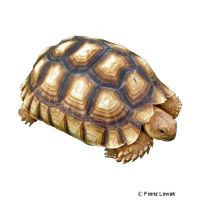African Spurred Tortoise (Centrochelys sulcata)
| African Spurred Tortoise Centrochelys sulcata | |
|---|---|
| Name | African Spurred Tortoise |
| Name Lat. | Centrochelys sulcata |
| Synonym | Geochelone sulcata |
| Family | Tortoises |
| Family lat. | Testudinidae |
| Order | Turtles |
| Order lat. | Testudines |
| Origin | Africa |
| Habitat | Dry savanna |
| Diet | Grass, herbs, hay, earthworms |
| Humidity | 40-60 % |
| Behavior | Peaceful |
| Keeping | Individual, harem |
| Care Level | Moderate |
| Reproduction | Oviparous |
| Housing | Dry terrarium |
| Life Span | 70 years |
| Protection | CITES Appendix II; EU Annex B |
| Metric Units | |
| Size | 80 cm |
| Temperature | 28-35 °C |
| Temperature Local | 35-45 °C |
| Housing Size | 800 x 400 x 100 cm |
| US Units | |
| Size | 31" |
| Temperature | 82-95 °F |
| Temperature Local | 95-113 °F |
| Housing Size | 300" x 150" x 40" |
Distribution and habitat
The distribution area of the spur-thighed tortoise is the African Sahel south of the Sahara from the Atlantic to the Red Sea. There they live in different vegetation zones in the dry-hot grassland and scrubland and in the semi-deserts.
Maintenance
Minimum dimensions for the terrarium, according to the size and number of animals
| 1-2 animals | 8PL x 4PL (L x W) |
The carapace length (PL) is measured on the largest animal. For each additional animal the footprint has to be increased by10 %, from the 5th animal on by 20 %. A terrarium of e.g.800 x 400 x 100 cm is recommended, which should be placed in a quiet and vibration-free place.
They need a terrarium structured with roots, robust plants and stones with a graveable substrate, e.g. of sand-loam-gravel mixture, as well as an easy to clean, large water basin as drinking and bathing possibility. A small portion of the substrate should always be kept slightly moist. If kept in groups, suitable separate retreats should be provided. For 4-6 months (rainy season) the humidity must be increased significantly. A rain or mist system is ideal
| Temp. day: 28-35 °C | Temp. night: 18-23 °C | Temp. local: 35-45 °C | Humidity: 40-60 |
Thermostatically controlled floor heating is recommended. Lighting duration must be 6-14 hrs, depending on the season. They need a high light intensity. Special lamps that produce the necessary heat and UV light are ideal. Daily UV irradiation is essential.
Diet
They are omnivores, but they feed almost exclusively vegetarian. The diet consists of a wide range of wild herbs (plantain, dandelion, parsley, etc.), grass, hay and hay dressings, clover, sweet grasses, mushrooms and vegetables such as lettuce, spinach, cabbage leaves, cucumbers, zucchini and carrots, supplemented with commercial ready-made food for tortoises. Occasionally they require small amounts of animal protein, such as earthworms, snails or grasshoppers, and small pieces of hard-boiled egg. Fruit should be fed sparingly and infrequently because of the fructose content. Regular addition of minerals and vitamins is important. Drinking water (drunk through the nose) must always be available. They like to drink and bathe.
A varied diet promotes health and prevents deficiency symptoms.
Reproduction and breeding
The males have a concave ventral carapace (plastron) and a much longer tail. Their marginal shields are more upturned, their femoral spurs are larger, and their throat shields are more pronounced. Mating occurs year-round, but cooler months are preferred. Egg laying occurs 2-3 times a year. The female buries her eggs, a maximum of 20 per clutch, about 30 cm deep in a sandy southeast-facing spot. The incubation period is 80-90 days. Life expectancy can be over 70 years.
Species protection
The animal population must be reported in writing to the competent authority immediately after the start of keeping. Your pet store will be happy to provide you with further information.
Species protection: WA Appendix II; EU Appendix B. The proof of purchase is the required proof of origin for the animal. Please keep it safe!
Important
They require adequate shelter (e.g., burrows) for thermoregulation. They are active all year round and do not hibernate in the conventional sense, but frequently take rest periods during the summer. Free-range housing is advised during the summer months, but a heated retreat must be available.
The terrarium must have good ventilation without drafts and meet the species specific needs. Measuring devices such as thermometers, hygrometers, etc. are necessary. The lighting has to correspond to the species-specific day-night rhythm and has to be placed in such a way that the animals cannot injure themselves. The terrarium should be locked in such a way that neither unauthorized persons can open it nor the animals can escape. Contamination must be removed regularly.
Further literature can be found in your pet store.
References
Text: Christian Sänger; Image: Franz Lowak
Source: BMELV (1997): Tierschutzgutachten - Mindestanforderungen an die Haltung von Reptilien; ENGELMANN (2006): Zootierhaltung - Tiere in menschlicher Obhut: Reptilien und Amphibien, Harri Deutsch Verlag
- Gemäß § 21 Abs. 5 Tierschutzgesetz idgF
